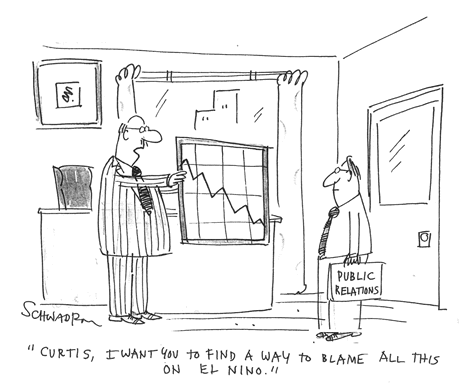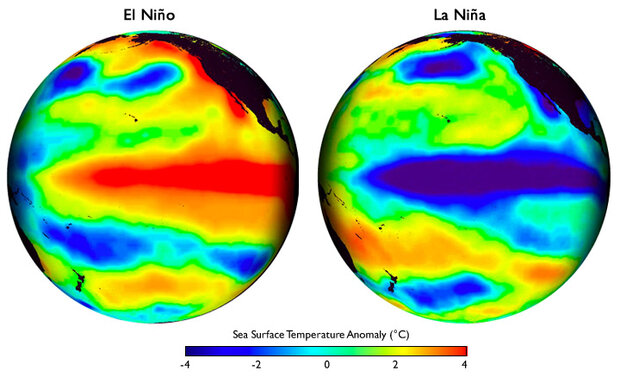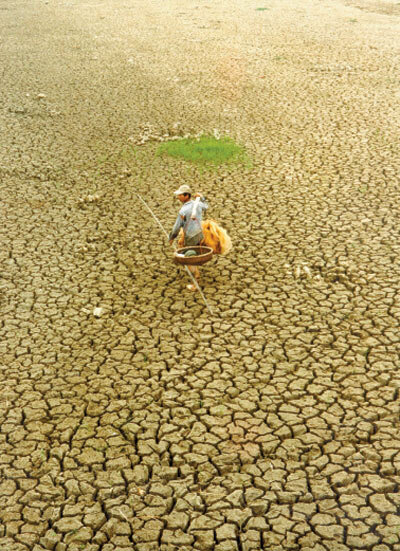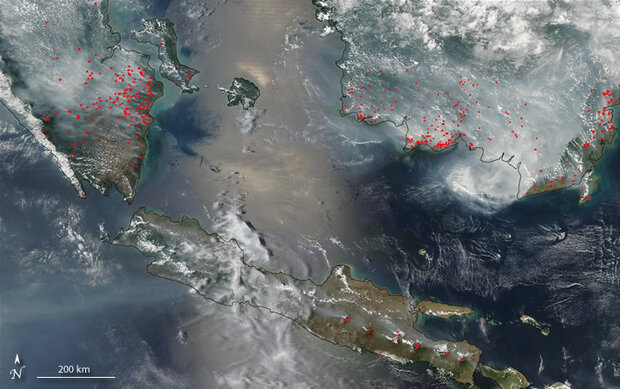Can We Blame El Niño?

For years, people have been pointing to El Niño as the culprit behind floods, droughts, famines, economic failures, and record-breaking global heat. Copyright by Harvey Schwadron; licensed through cartoonstock.com.
For years, people have been pointing to El Niño as the culprit behind floods, droughts, famines, economic failures, and record-breaking global heat. Can a single climate phenomenon really cause all these events? Is the world just a step away from disaster when El Niño conditions develop?
What Is El Niño?
El Niño refers to conditions when the sea's surface in an area along the equator in the central and eastern Pacific Ocean gets warmer than usual. The average water temperature in that area is typically just 1-3°C (about 2-5°F) warmer than normal, but it has the effect of adding huge amounts of heat and moisture to the atmosphere, ultimately affecting patterns of air pressure and rainfall across the Pacific and beyond.
La Niña is the climatological counterpart to El Niño-a yin to its yang, so to speak. La Niña refers to periods when sea-surface temperatures in the equatorial central and eastern Pacific are cooler than normal. The lower surface temperatures suppress transfer of heat and moisture to the atmosphere, again affecting air pressure and precipitation patterns across a large region.
These global maps centered on the Pacific Ocean show patterns of sea surface temperature during El Niño and La Niña episodes. The colors along the equator show areas that are warmer or cooler than the long-term average.
El Niño and La Niña episodes tend to recur every three to seven years, with each set of conditions settling in for about a year. The "seesaw" of high pressure in the western Pacific associated with El Niño shifting to high pressure in the eastern Pacific associated with La Niña is known as the Southern Oscillation. The oft-used term El Niño-Southern Oscillation, or ENSO, describes the alternating states of the linked ocean-atmosphere system as well as the normal state that occurs between them.
Why Does it Matter?
El-Niño-related drought can reduce food availability in regions where agriculture is dependent on rain.
Outside of normal seasonal variation, ENSO is one of the main sources of year-to-year variability in Earth's weather and climate, with significant socioeconomic implications for many regions around the world. In normal years, trade winds push warm water and its associated heavy rainfall westward from the central Pacific toward Indonesia. During an El Niño, the winds die down and can even reverse direction, pushing the rains toward South America instead. This is why people in Indonesia and Australia typically associate El Niño with drought, while people in Peru connect El Niño with floods.
These changing climate conditions, combined with other factors, can have serious impacts on society: impacts include reduced crop harvests, wildfires, or loss of life and property in floods. Public health records also offer evidence that El Niño conditions increase the risk of certain vector-borne diseases, such as malaria, in places where they don't occur every year.
Misconceptions about El Niño
Since its discovery, people have been trying to understand and explain ENSO by generalizing its effects or connecting it to all extreme weather events. As a result, people may hold some ideas about El Niño that aren't necessarily true. The following brief discussions can clear up some common misconceptions about El Niño.
Misconception #1: All the impacts of El Niño are negative.
Fires in southeast Asia, droughts in eastern Australia, and flooding in Peru often accompany El Niño events. Much of the media coverage on El Niño has focused on the more extreme and negative consequences typically associated with the phenomenon. To be sure, the impacts can wreak havoc in developing and developed countries alike, but El Niño events are also associated with reduced frequency of Atlantic hurricanes, warmer winter temperatures (and reduced heating costs) across the northern United States, and plentiful spring/summer rainfall in southeastern Brazil, central Argentina and Uruguay, which leads to above-average yields from summer crops.
Misconception #2: El Niño periods cause more disasters than normal periods.
On a worldwide basis, this isn't necessarily the case. In some regions, we've seen that El Niño exerts fairly consistent influences on climate. For example, El Niño conditions typically cause more rain to fall in Peru, and less rain to fall in Indonesia and Southern Africa. Combined with socioeconomic factors, these conditions can make a country or region more vulnerable to adverse impacts.
However, compared with normal conditions, characteristic El Niño patterns enable climate scientists to produce more accurate seasonal forecasts and better predictions of extreme drought or rainfall for several regions around the globe. In turn, this improved predictability can help societies be better prepared to avoid or reduce potentially negative impacts. Ultimately, with better predictions, fewer areas with increased vulnerability may develop as disasters.
Misconception #3: El Niño and La Niña significantly affect the climate in most regions of the globe.
Actually, El Niño and La Niña significantly affect only about 25% of the world's land surface during any particular season, and less than 50% of land during the entire time that ENSO conditions persist.
Misconception #4: Regions that are affected by El Niño and La Niña see impacts during the entire 8 to 12 months that the climate conditions lasts.
Most regions experience impacts only during one specific season, and this can be months after the ENSO conditions first develop. For example, the recently developed 2009 El Niño may cause the southern U.S. to get wetter-than-normal conditions from December to March, but Kenyans may see wetter-than-normal conditions between October and December.
Misconception #5: We should worry more during El Niño episodes than La Niña episodes.
Not necessarily. Each set of conditions come with their own features and risks. In general, El Niño is associated with an increased likelihood of drought across tropical land areas, whereas La Niña is associated with an increased risk of drought in the mid-latitudes.
Smoke blankets the western portion of Indonesia during a moderate El Niño late in 2002. Red dots indicate areas where fires were actively burning. MODIS image courtesy of NASA.
Misconception #6: The stronger the El Niño/La Niña, the stronger the impacts, and vice versa.
Not necessarily. The important point to remember is that ENSO shifts the odds of some regions receiving more or less rainfall than they usually do, but it doesn't guarantee that this will happen. For example, scientists expected the very strong El Niño of 1997/98-which triggered wildfires in Indonesia and flooding and crop loss in Kenya-might also result in below-normal summer rainfall in India and South Africa, but this didn't happen. On the other hand, India experienced strong rainfall deficiencies in 2002, during a much weaker El Niño.
Also, there are other large-scale climate oscillations at work in the global climate system. Sometimes when these other oscillations-such as the Pacifical Decadal Oscillation or the North Atlantic Oscillation-are happening at one of their peak phases, their effects can dampen or even completely offset the effects from an ENSO event.
Misconception #7: El Niño and La Niña events are directly responsible for specific storms or other weather events.
Just as we can't blame any particular hurricane on global climate change, we can't confidently pin a single weather event on an El Niño or La Niña. ENSO conditions typically affect the frequency or strength of weather events. What we can say from climate records is that over the course of a season with El Niño or La Niña conditions in place, some regions experience more or less rainfall than average.
Misconception #8: El Niño and La Niña are closely related to global warming.
El Niño and La Niña are a normal part of Earth's climate system and have likely been occurring for millions of years. Global climate change may affect ENSO cycles, but the research on this connection is still underway.
Francesco Fiondella is a science communicator at the International Research Institute for Climate and Society at Columbia University. Another version of this article originally appeared on the IRI Web site.
The International Research Institute for Climate and Society maintains an ENSO page full of resources on El Niño and La Niña. Visit the page to see the latest information on current El Niño conditions as well as forecasts for upcoming seasons.
For Further Information
IRI's Madeleine Thomson discusses the effects - good and bad - that El Niño could have on public health around the world in an audio interview.
References
Goddard, L., and M. Dilley, 2005: El Niño: Catastrophe or Opportunity? J. Climate, 18, 651–665.


